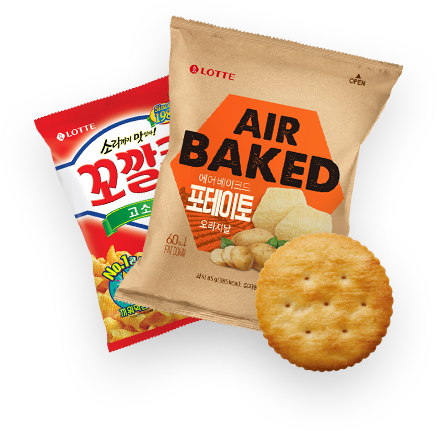So when did we start
eating biscuits and snacks?
-

The crudest form of a cracker was made by harvesting and grinding wild wheat and mixing the powder with water.
Examples were found in ancient Egyptian tombs dated back to around 4,000 BCE. Somehow, wild yeast found its way into these biscuits, fermenting the dough and producing bread. This was the birth of confectioneries. By the time of Greek civilization, confectionery technologies had progressed considerably, and some 80 to 90 varieties of breads and crackers were being made and consumed regularly. Some contained fruit, others were flavored with cheese or honey, and others were fried.
-

The modern biscuit industry began in England, which harnessed the improved navigational technologies of the 19th century to colonize the world.
Handmade biscuits were eaten as emergency survival food during long voyages or wars, and rapid progress in machinery during the Industrial Revolution accelerated progress in biscuit manufacturing equipment and technologies. Breads and confectioneries as we know them today developed following the introduction of coffee, cocoa And sugar from the New World around the 16th and 17th centuries CE. These ingredients brought about massive progress in the variety of confectioneries and the techniques used to produce them. Confectioneries entered the mainstream, and stores specializing in them were opened by professional confectioners.
What types of confections
are there?
-
Biscuit
The crudest form of cracker was made by harvesting and grinding wild wheat, and mixing the powder with water.
Examples were found in ancient Egyptian tombs dated back to around 4,000 BCE. The modern biscuit industry began in England, which harnessed the improved navigational technologies of the 19th century to colonize the world. ‘Bread’ was a poor emergency food as its high moisture content (35 to 40%) made it prone to spoilage. There was a need for bread which had lower moisture content. The name ‘biscuit’ provides some clues as to how this was achieved: biscuit literally means ‘bread baked twice’, from bis (once more) and cuit (cooked). According to another theory, an English ship sought shelter at the port of Biscay, between France and Spain, in the age of Napoleon in the early 19th century. Out of provisions, they mixed what flour they had into a dough and cooked it on a hot metal plate. While early biscuits were mostly handmade as a type of emergency food for long voyages or war, the Industrial Revolution brought about rapid progress in biscuit manufacturing equipment and technologies. Biscuits then went global.Baking bread twice produced hardtack, and adding eggs, sugar and oil to the flour dough gave rise to the biscuits we know today. Note that the term ‘biscuit’ refers to different things in different countries. In the broad sense, cookies, crackers and scones all fall under the category of ‘biscuit’. Biscuits are usually made of flour, sugar and fat, with a moisture content of less than 4%. This gives them a relatively long shelf life, making them a great nutritious emergency food or snack. -
Snack
A snack is generally defined as a food that does not burden the stomach and that goes through a simple drying, steaming or bulking process to impart a crunchy texture. A snack is given complex flavors and aromas through various coatings or seasonings. Snacks were introduced into Korea in the early 1970s. The raw ingredients for snacks are usually corn or potatoes.
-
Cookie, Cracker
The word ‘cookie’ comes from the Dutch word ‘koekie’, which means ‘small cake’. Generally, cookies are made using more butter than biscuits. In the United States, biscuits containing sugar are called cookies, while those that do not are called crackers. An American-style cookie is made by stirring sugar into butter and shortening to make a creamy paste, to which eggs, flour, backing powder and flavorings are added. The dough is then rolled into thin sheets, and cut into various shapes with a cookie cutter. The shapes are then baked in an oven. Depending on the consistency of the dough or batter, cookies can be based in a variety of ways. Some batters are squeezed out of a tube onto a baking sheet, spooned out (drop cookies), or left in the fridge to set bfore being cut into slices and baked in the oven (ice box cookies). Crackers were named after the sound they make when they are eaten. Crackers tend to crumble in the mouth and have a gentle sweetness that makes them ideal for having with coffee or tea. Crackers are made with a yeast-fermented dough, or a dough containing backing soda to help it rise. Cookies and crackers can both be considered types of biscuits.

